Apron for the kitchen: height, colors and design ideas
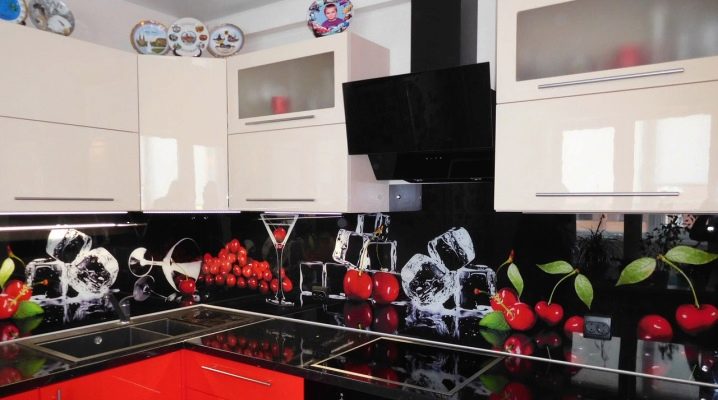
The kitchen is a place where the whole family gathers for lunch and dinner. Often it also serves as a place for informal gatherings with friends or conversations with a friend over a cup of coffee. The kitchen space can be combined with the living room, and also serve as a real culinary workshop for the mistress of the house. Each of these cases involves the creation of a cozy and comfortable interior, which means that it is necessary to take care not only of functionality, but also of the appearance of one of the main rooms of the house.
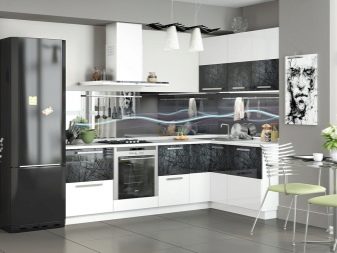
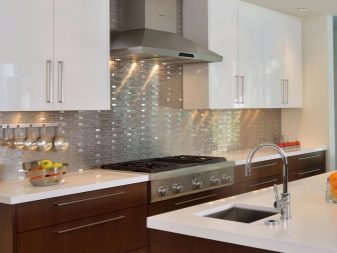
Particularly noteworthy is the area above the stove and sink, where drops of water and accidental splashes of fat most often fall during cooking. Therefore, ordinary wallpaper or decorative plaster is not suitable here, because it is advisable to wash the surface after each cooking. To simplify this process and preserve the material, the work area is decorated with a special kitchen apron.
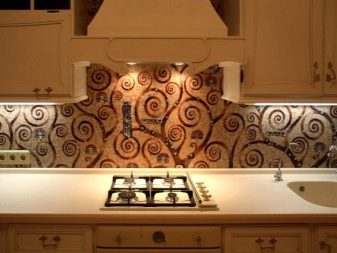
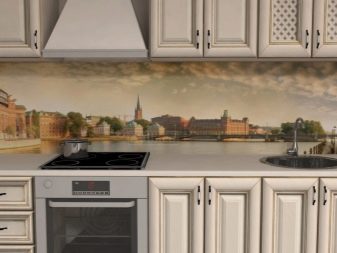
Peculiarities
A kitchen apron is a covering that frames the kitchen work area and protects surfaces from fumes and greasy drops during cooking. In addition, the apron is located at eye level and can be extended along the entire perimeter of the kitchen, and therefore is one of the main elements of the room decor.
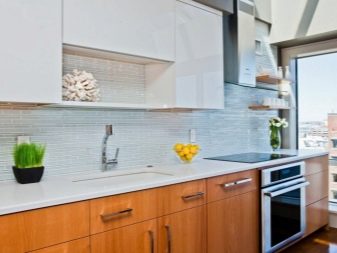
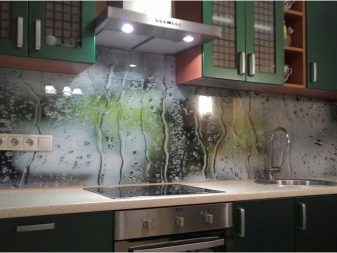
The material for facing the working area is selected taking into account the style and color scheme of the room. It is equally important that the cladding is resistant to moisture, high temperatures, and cleaning agents. Dirt should be easily removed without being absorbed into the surface, and maintenance of the apron should not leave mechanical damage on it.
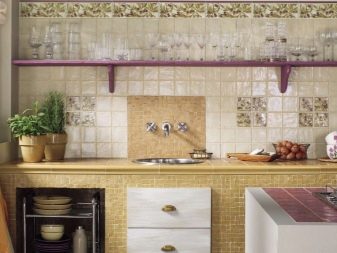

The building materials market offers a huge number of panels for creating kitchen aprons, and sometimes it can be incredibly difficult to make the best choice. To simplify the task, the designers recommend, for a start, to put together all the pieces of materials that were used to decorate the room: the texture and color of the headset, wallpaper or other wall cladding, a fragment of the floor covering, countertops.
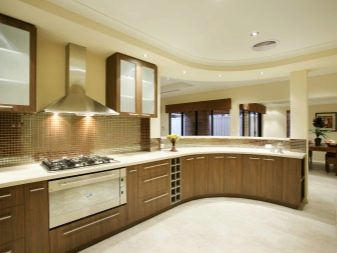
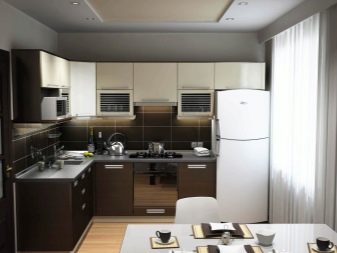
But this is only the first step towards planning the future framing of the work area. Let's take a closer look at all the nuances of this functional decor element.


Views
In the catalogs of specialized stores, as well as on the websites of manufacturers of finishing materials, you can find all the necessary information about the products they offer. However, it should be remembered that such descriptions are always of an advertising nature and can captivate an inexperienced consumer with a bright picture. Subsequently, it may turn out that the purchased material, although it has quality, either does not fit into the overall interior, or does not harmonize in texture, does not withstand the load at the level of culinary work in your kitchen.
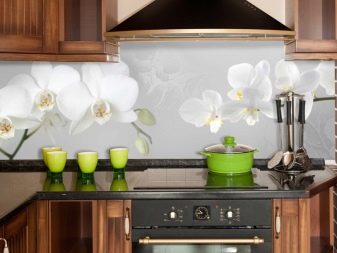
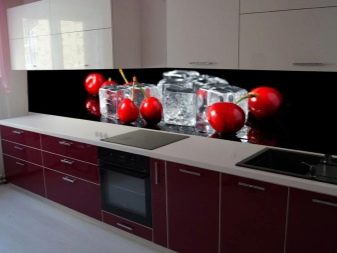
To avoid such mistakes, it is worthwhile in advance with a "cool head" to understand all the proposed types of materials for kitchen aprons.
Ceramic tile
The tiled kitchen apron has long been a classic. An inexpensive material with increased strength has been used for decades in kitchens in many countries of the world. The material has significant advantages over analogues, which are either absent at all, or presented to a lesser extent in other coatings.
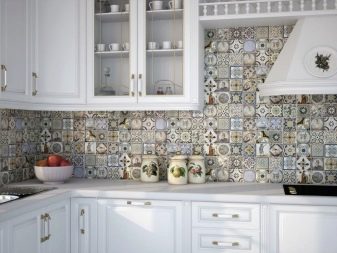
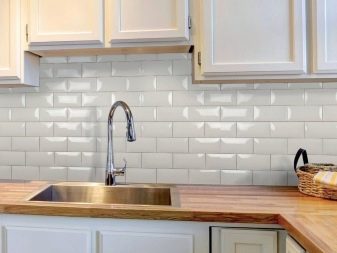
- The main quality of the tiles is ease of maintenance. It does not absorb water and grease, does not deform under the influence of steam. Any dirt remains on the surface and can be easily cleaned off with a damp sponge and dishwashing detergent. Old dirt can be removed with abrasive cleaning agents, especially if the tiles are matte - their surface will not be damaged or scratched.
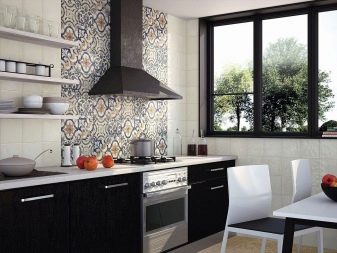
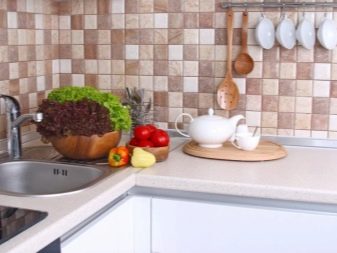
- The durability of the material is considered equally important. The tiles are laid out, as they say, for centuries. It will not fade in the sun and will not fade with time, will not collapse from constant interaction with high temperatures and vapors.


- The material belongs to the safest in terms of fire resistance - with it you can not worry about accidental fire, it will not melt from too high a temperature near gas burners.
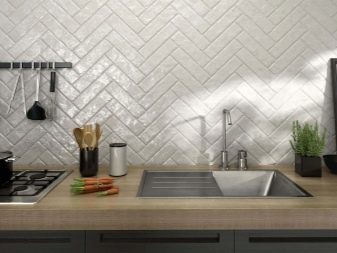
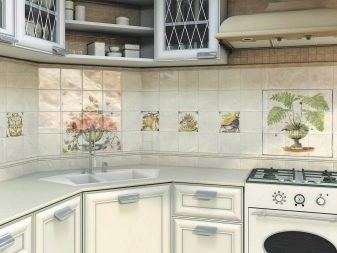
Ceramics are available for sale in a wide range of colors. There is an opportunity not only to choose a tone and small drawing, but also to lay out a voluminous panel, to create a thematic picture.
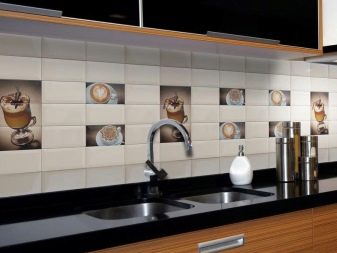
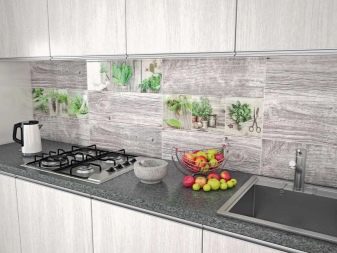
Quite a popular option is ceramic tiles styled in marble, wood or granite. You can pick up copies of various textures: smooth and voluminous, convex, glossy, matte. Also in a wide range of sizes and shapes.
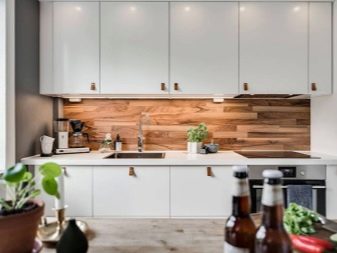
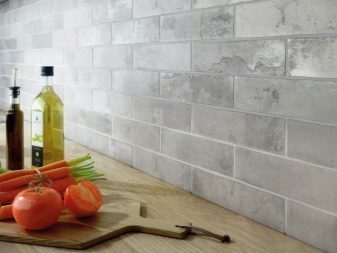
But before making a choice in favor of tiles, it is worth learning about the disadvantages of a ceramic backsplash for the kitchen.
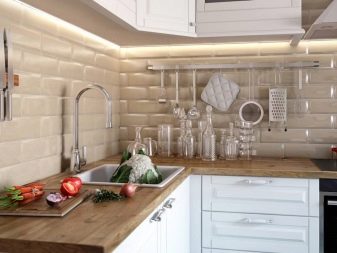
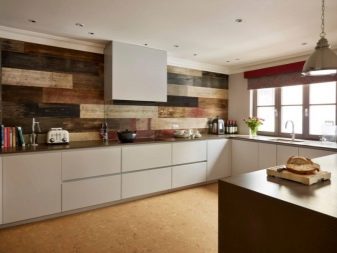
- The first thing to consider is the complexity of the installation process. To lay tiles with high quality, you need to have at least minimal skills and remember that this process is part of a full-fledged repair. Therefore, it is better to lay the tiles in advance, at the stage of finishing the entire room.
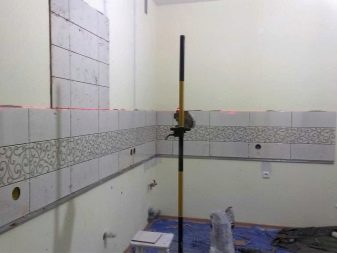
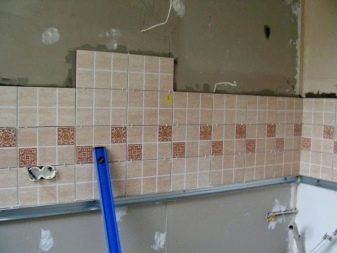
- For wall cladding with ceramics in addition to tiles, additional costs will be required: glue suitable for this material, leveling mortar, grouting mixture.
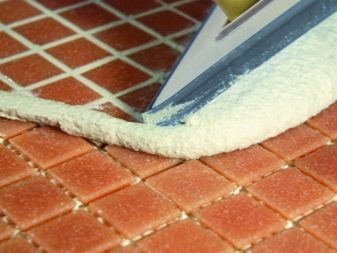
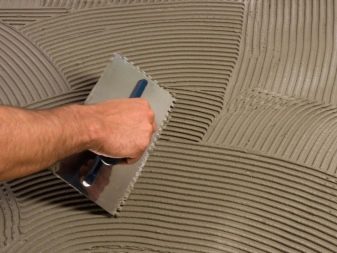
- Another problem with tile aprons is the joint seams. If the tile itself does not absorb dirt and is easy to clean, then fat particles will just accumulate between the joints - the trowel mixture will become a favorable medium for the accumulation of dirt. Therefore, it will have to be periodically cleaned with a brush and special solutions, renewed and impregnated with antifungal agents.
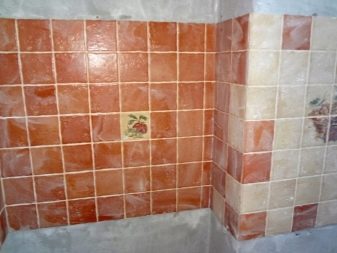
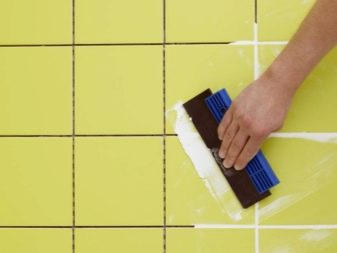
Mosaic
Mosaic patterns are laid out from small particles of any durable material. With their texture and aesthetic appearance, they will give the surface an embossed convex appearance. Artistic panels are made of mosaics in the form of full-fledged paintings or pieces are mixed in a multicolored random order - both methods deserve attention.
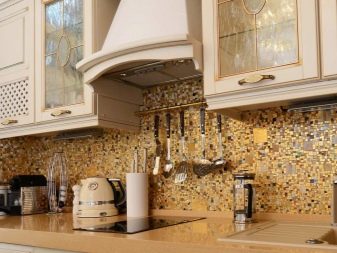
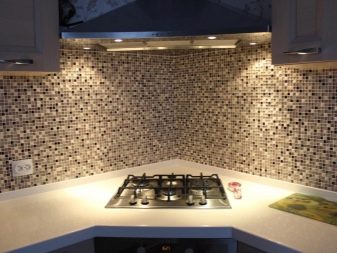
The material for the mosaic can be both ceramic tiles and less popular materials: wood, stone, colored glass. The apron, made up of small pieces, is durable and strong. Easy to clean while visually concealing random dirt, unlike flat panels, which show any drops.
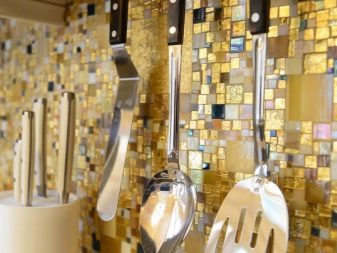
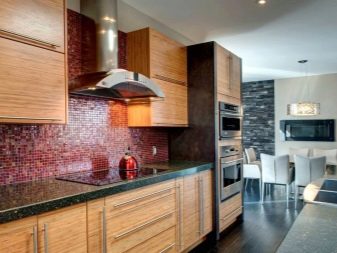
A mosaic made of stone or wood will give the kitchen an exquisite and respectable look, multi-colored glass, metal or mirror pieces will glare and shimmer, focusing on themselves.
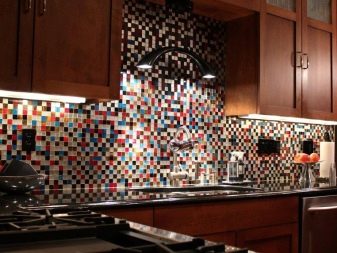
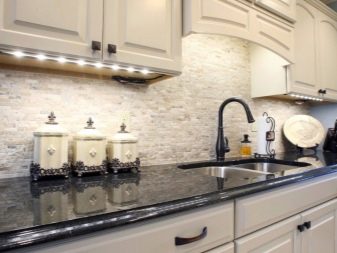
Mosaic kits are found on sale in different variations. Elements can be both very small - 1x1 cm, and larger - 5x5 cm.
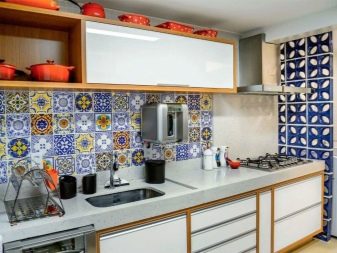

The disadvantages of mosaic decoration include the same problem as with ceramic tiles - a large number of joint seams that accumulate dirt. It is also worth adding here the rather high cost of material and work, as well as the complexity of laying.

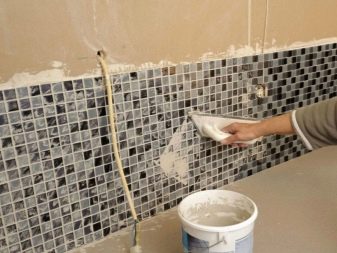
Laying is carried out by analogy with the design of tiles, however, the small sizes of mosaic puzzles make the work time consuming and painstaking... To simplify the process, professionals advise to pre-lay out the mosaic on a separate canvas or volumetric squares, and only then glue the base on the wall. Of course, this applies only to those surfaces, the area of which allows it to be done.
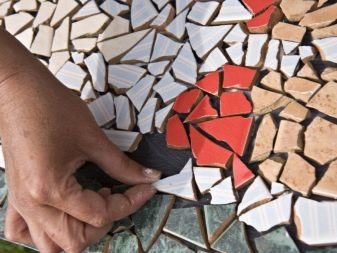
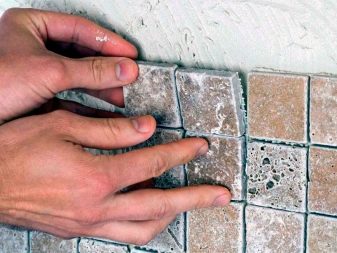
One of the main advantages of mosaics is the convenience of decorating the space around sockets, switches, wall protrusions, while large squares of tiles have to be cut to fit the built-in details. The mosaic can be easily laid on rounded and not too flat planes, visually hiding the imperfections of the walls.
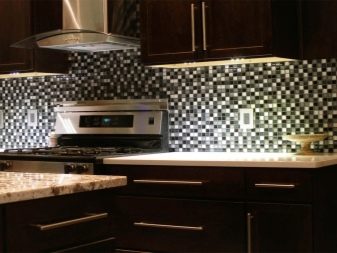
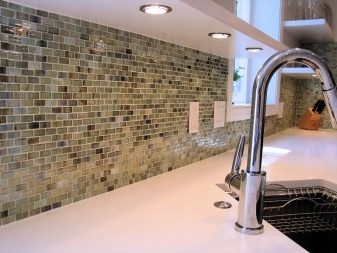
Wood and MDF
Wooden aprons are far from the most practical option for the kitchen. The tree absorbs moisture well, and also tends to dry out. Wood coatings deteriorate from abrasive cleaning agents, may change color from moisture and sunlight, and become saturated with odors over time.
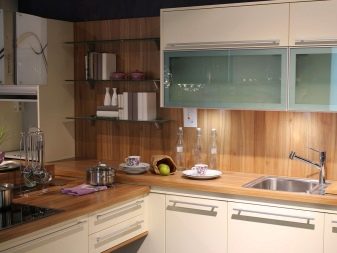

But sometimes a design idea can outweigh practicality, and a wooden apron will truly become a decoration of the kitchen, create an atmosphere of coziness and comfort. In addition, wood may be necessary for decorating rooms in country, rustic or chalet style. In such cases, the wood coating is preliminarily subjected to a thorough treatment with oils and protective varnish. Often a wood kitchen panel becomes a color and textured addition to a table set.
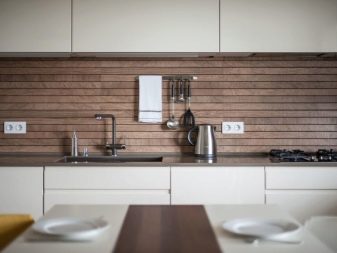
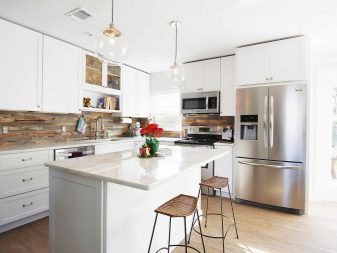
A wooden apron can be protected with thin glass or you can choose a more budgetary and unpretentious option - an MDF panel.
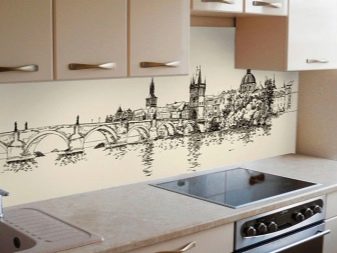
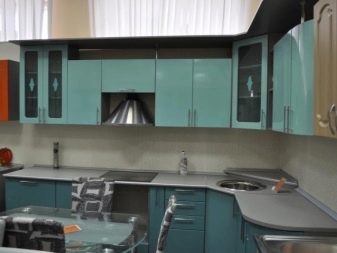
MDF material is a compressed wood chip impregnated with a special binder. The advantages of such panels include low cost - MDF will cost much less than tiles, stone or glass. Ease of installation is another advantage - the cladding can be handled without even having the skill of repair work. MDF boards do not have a wide variety of colors, but you can always choose from them the option "under a tree" of one or another shade. The plus is that such plates are easy and not a pity to replace when they become unusable.
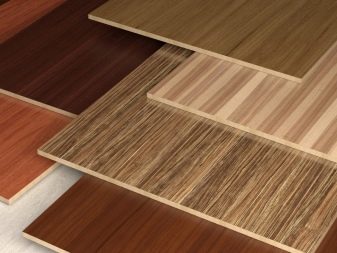
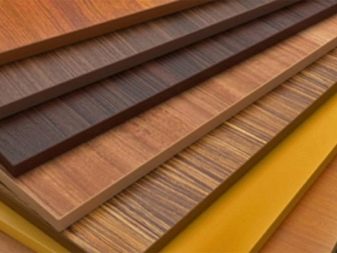
The characteristic disadvantages of a wood apron include:
- fragility;
- high flammability;
- absorption of moisture and odors;
- sensitivity to cleaning agents and mechanical damage.
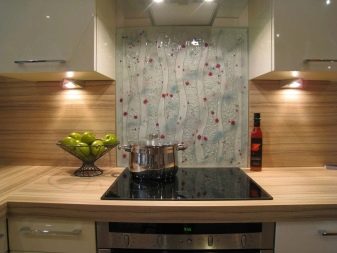

HDF panels
Not so long ago, the construction market was filled with another type of wood-based panels - HDF. Their main difference from MDF is the high density of the material obtained by hot "dry" pressing of smaller wood fibers. Due to the pressing technology, the plate is twice as thin as MDF counterparts, but at the same time it has increased strength. With the correct installation of the product in compliance with the technology, the material will last at least 5-10 years.
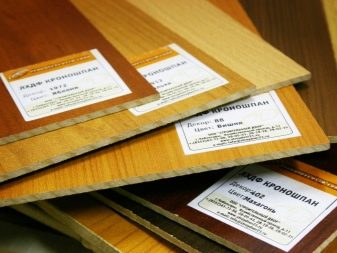
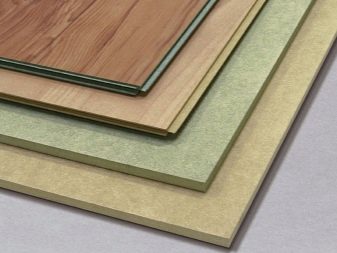
However, the material has the same disadvantages as MDF boards:
- woody structure tends to turn yellow or fade in the sun, that is, change color in certain places;
- the varnished coating may acquire yellowish spots after several years;
- in a room that is too humid, there is a risk of fungal growth between the kitchen surface and the wall.
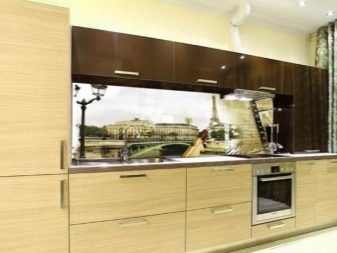
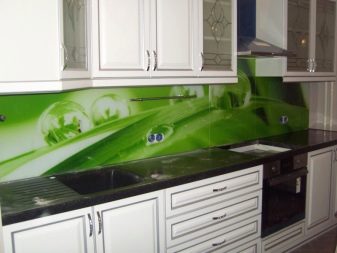
However, with proper installation and early surface treatment, the problem of mold will not arise.
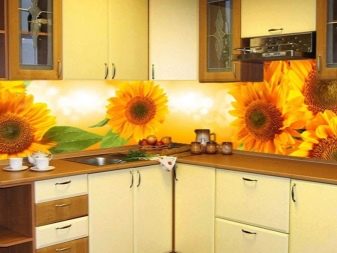
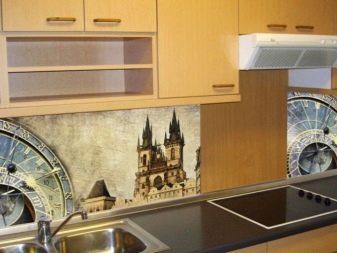
HDF boards have several varieties.
- Sanded. The easiest panel processing option. They differ from MDF only in greater density, but just like their analogue they are processed with varnish and paint.
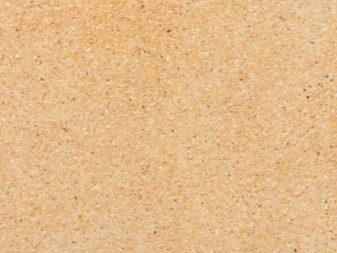
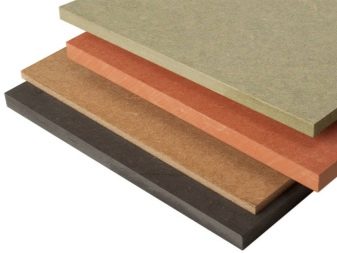
- Lacquered. A more expensive option, coated with a primer paint to give a certain texture. Such panels can imitate various types of wood. For protection, they are additionally covered with a thin layer of varnish.
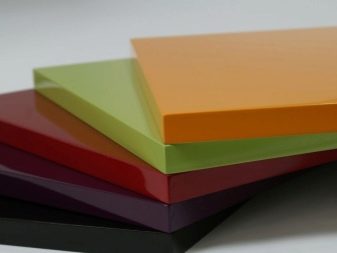

- Stylized as a stone or tile. They may have veins or blotches that imitate natural materials: marble or granite. They are small in size (like a tile) or are represented by a solid panel.

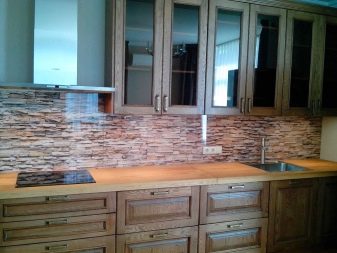
- With photo printing. This option is the most popular for its wide range of decor options and durable topcoat. The boards are manufactured using a special HDF + technology and contain alkyd components.Thanks to this, photo-printed boards - the only ones of all HDF materials - are not exposed to sunlight, do not turn yellow or tarnish over time.
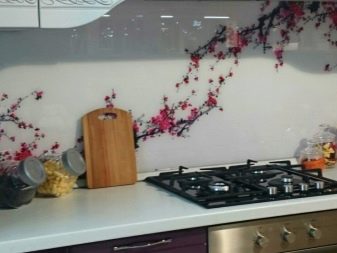
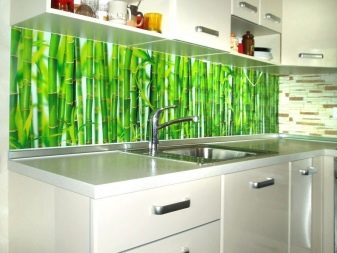
Strained glass
Kitchen aprons made of glass have gained popularity relatively recently, but this material still causes some caution among consumers. Glass is considered fragile and therefore fragile and unsafe. Recently, however, an option of tempered glass has become available, from which shower cabins, doors for sideboards and showcases, decorative fences and much more are made.
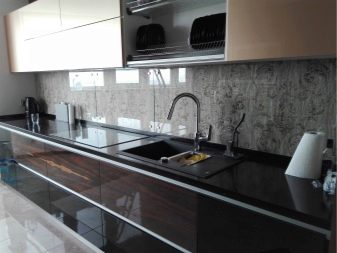
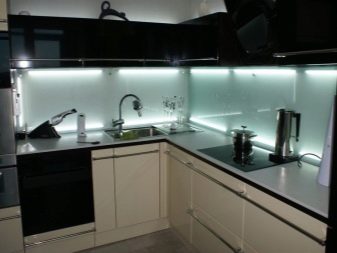
Tempered glass is obtained by heat treatment of ordinary glass sheets, first heating them to a high temperature, and then sharply cooling them with a strong minus.
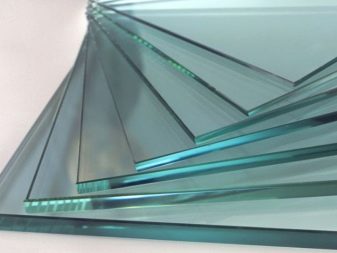

The result is glass, the strength of which is increased by 5-7 times. Moreover, the glass becomes practically safe, since even when destroyed, it crumbles into small pieces, the edges of which are dull. In other words, in case of mechanical damage, for example, a strong impact, the glass is more likely to "crumble" than break, and the risk of being cut is minimized.


At the same time, the optical properties of glass during tempering do not change at all - it remains completely transparent.

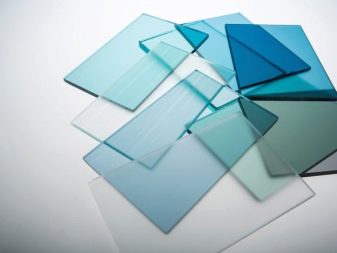
Tempered glass has several advantages over other materials:
- a few millimeters thick makes the glass strong enough not to be afraid of accidentally touching and breaking it;
- scratches from dishes and other mechanical damage do not remain on it;
- not afraid of temperature changes, exposure to steam and the proximity of gas burners;
- easy to clean with ordinary detergents, does not absorb moisture, does not deteriorate from household chemicals;
- one-piece fabric and the absence of seams eliminates the problem of tile joints, which require constant cleaning.

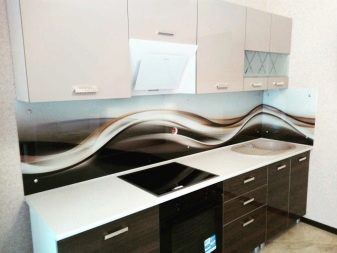
The disadvantages include the rather high cost of the material, as well as the need to order the canvas according to individual sizes, since it is very problematic to cut glass at home.
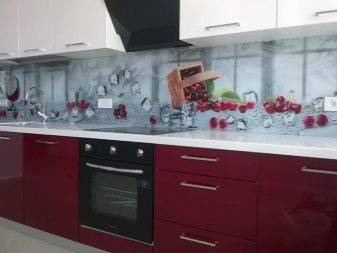

Glass aprons are mounted either on liquid nails, creating the illusion of weightlessness, or inserted into a frame or special holders.
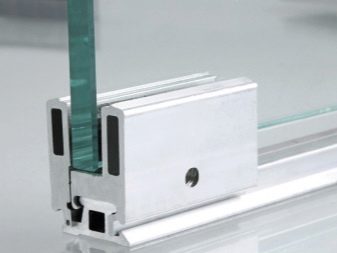

The design of glass aprons can be very diverse. Glass is often used as a protective shield for another material, such as wood. This is a convenient option to preserve the woody texture and color of a wooden backsplash for years to come. But glass can serve as a decorative element by itself.

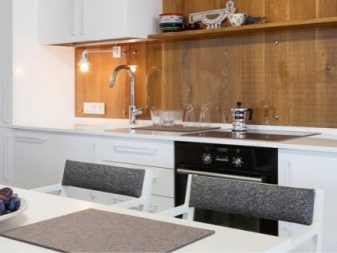
- On the reverse side of the transparent glass, photo printing is applied partially or completely, thereby creating thematic paintings that are suitable for interior design.
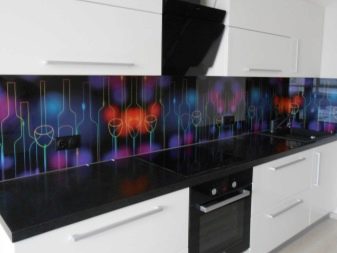
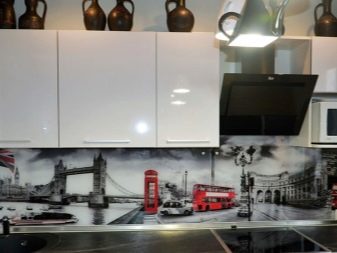
- The glass can be completely opaque, imitating haze, or thinned with transparent sketches. It can be abstract "frosty" patterns all over the canvas or a thematic drawing that emphasizes the style of the room.
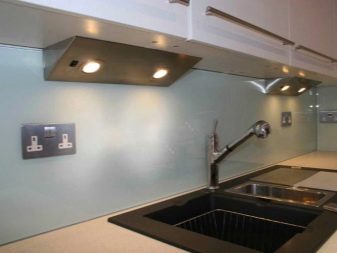

- Another option is clear glass with sandblasted or laser engraving. In the first version, the technique of spraying sand particles along a stencil is used, and the second involves the action of a laser beam on the previously drawn contours of the pattern - the top layer of the coating is removed with a laser, leaving a matte track.


- Spot lighting located behind the glass facade allows you to focus on patterns or designs, and in the evening twilight gives the kitchen a particularly aesthetic look.
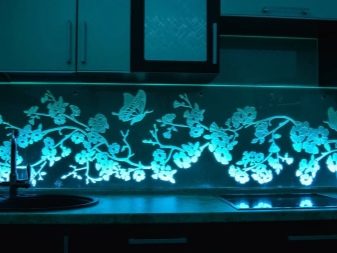
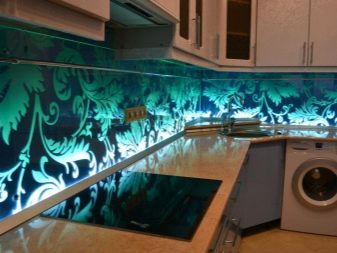
Mirror
Modern mirror panels are not inferior in strength to tempered glass and have the same advantages: they are easy to clean, do not absorb moisture and odors, and do not fade. They are not afraid of fungus or mold, they are not afraid of aggressive chemicals.
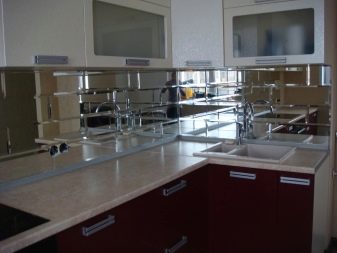
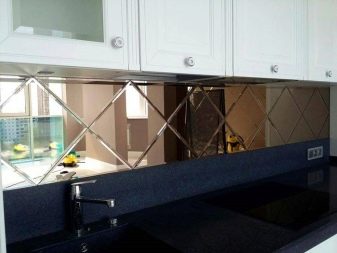
The main advantage of a mirrored apron is that it visually increases the space. The mirror will not only reflect the room, creating the illusion of spaciousness, but also increase the amount of light.At the same time, a spotlight built-in on top of the mirror panel or wall sconces becomes a particularly striking option.
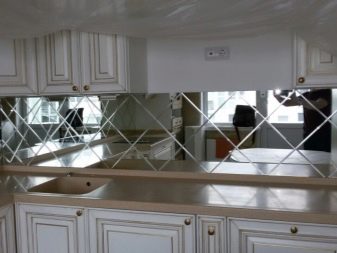

A mirrored apron, like a glass one, is decorated with a sandblast pattern, or a matte ornament is drawn with laser engraving. In this case, on the mirror surface, the contours of the pattern will be duplicated, giving the image volume and partial shade.
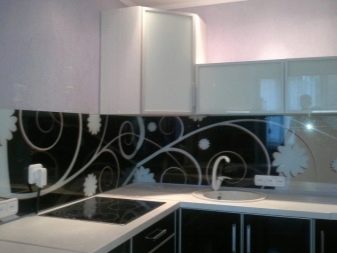
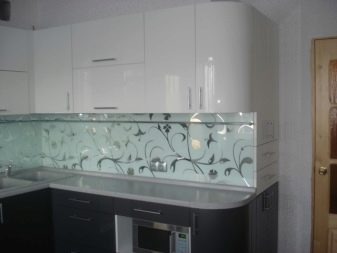
However, a mirror sheet is not a budget option - this is one of its main disadvantages. This also includes the need to order mirror material, because at home it is almost impossible to cut it to the required size.
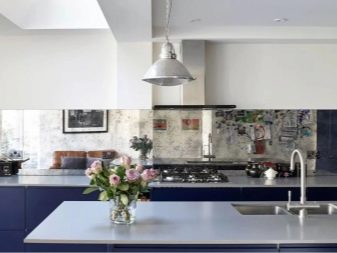
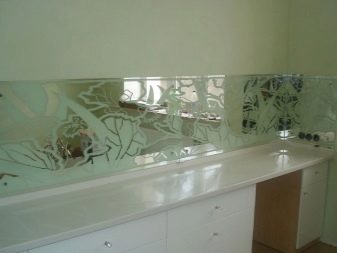
Before ordering a mirror apron, you should decide on its design. There are three types of mirrors for wall cladding.
- Solid panel. It is a continuous canvas without joints, ideal for visually increasing the space. The difficulty lies in the transportation of the volumetric panel, and installation requires the utmost care.

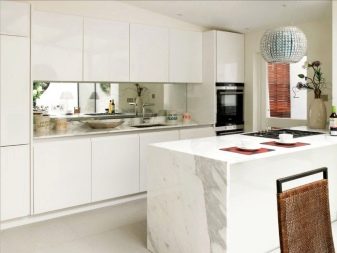
- Tile. Elements of the same size are laid out on the supporting surface, the joints are filled with a transparent or colorless sealant. Tile sets differ in size and shape, they can be in the form of squares, rectangles, rhombuses.

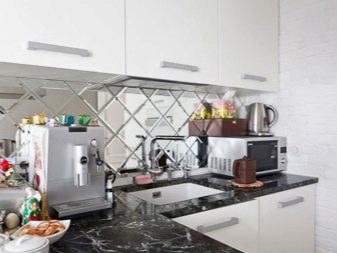
- Mosaic. Small mirrored pieces, put together in a single canvas, fill the space with thousands of light reflections, give the interior an additional shine and brightness. However, you should not count on a special visual increase in the space with mosaic mirrors - they are too small and can only reflect light.
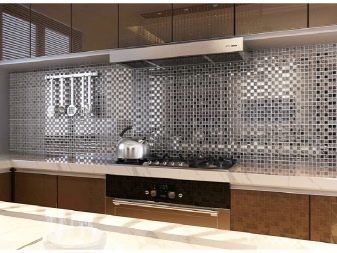
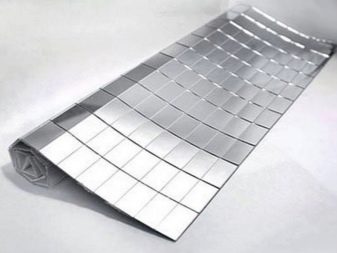
Dimensions (edit)
Since the very concept of a kitchen apron involves facing the entire space between the top and bottom of the headset, its height will also depend on the distance between the cabinets. Sizes of 45-60 cm are considered standard, and within these 15 cm each housewife chooses for herself the optimal height for her height. This is important so that it is convenient to reach the top cabinets while cooking.
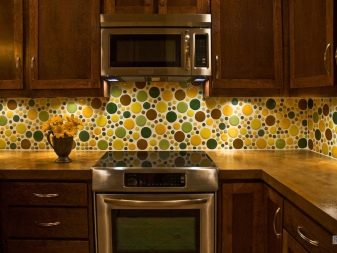

Accordingly, the kitchen apron will be of the same height, plus an allowance at the top and bottom of 1–2 cm, so that the edges of the apron go under the furniture, leaving no chance for accidental splashes of fat and water.
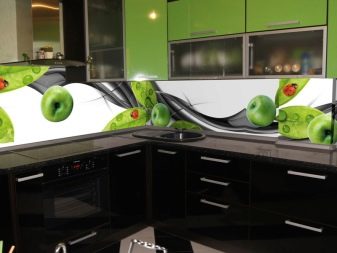
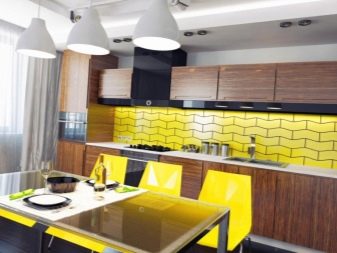
If the upper part of the headset is absent, then, from the point of view of practicality, it is advisable to bring the apron to the ceiling, and lay out a decorative plinth on top.

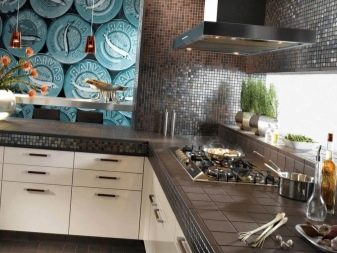
The length (or width, length) of the apron, as a rule, depends on the size of the headset - the apron ends behind the last cabinet. If there is no desire or opportunity to make the apron complete, you can limit yourself only to the zone of the stove and sink - these places are more prone to pollution than others. In this case, the apron will be fragmentary, and you can beautifully beat it, make a bright accent on it.
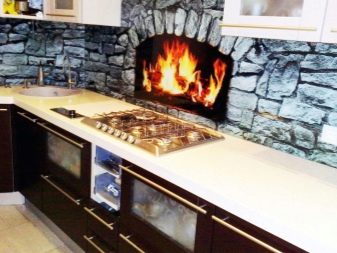
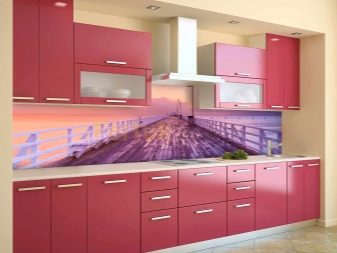
If the sink is located near the wall, then it is worth choosing the corner version of the apron in order to protect all surfaces from splashes.
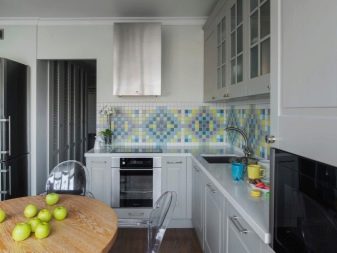
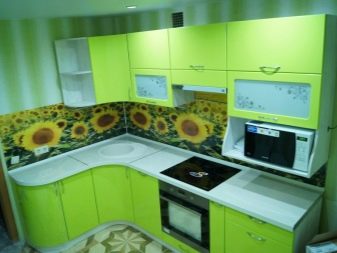
Separately, it is worth considering the hood above the stove. If it is not built into the upper part of the headset, then it is placed at a height of 70–80 cm, which means that the height of the apron will increase significantly under the hood itself. This should be remembered when calculating materials.

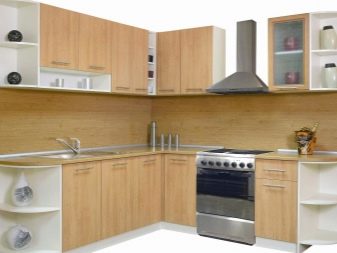
Design and decoration options
Thinking over the "style" and color design of the apron, of course, you should focus on the overall style of the kitchen. However, one should not forget that there are some nuances and tricks that make it possible to make the kitchen space the most harmonious and as comfortable as possible.
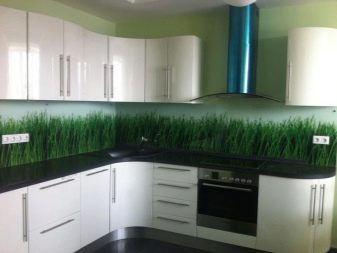
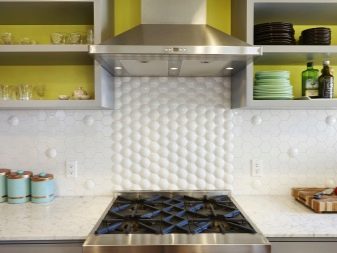
- The location of the kitchen is of great importance. If the windows face north, then natural daylight will not be enough. At the same time, the working area of the kitchen may turn out to be a dark corner, cluttered with cabinets and household appliances. It is especially important to focus on the apron in light colors. You will also need a built-in backlight. An ornament glowing in the twilight will also look good when the kitchen light is turned off.
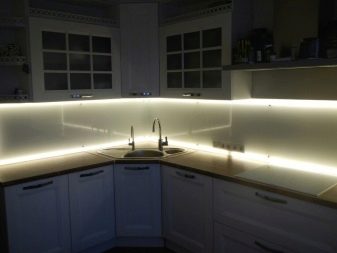

- The size of the room also dictates its own rules. Any light colors are suitable for a small kitchen - they visually expand the space, fill it with light. Based on this, it is worth choosing a kitchen apron one tone lighter than the headset. Or if the color is chosen for the decoration of the walls, then one tone is darker than the wall covering. In this case, the apron will stand out beautifully and blend in with the surrounding space. It is not necessary to choose white - it may well be replaced by beige, coffee or bluish stains.
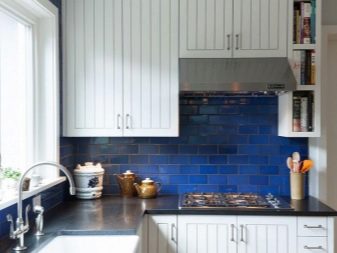
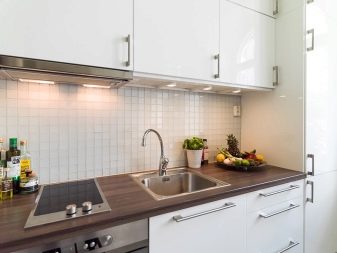
- In voluminous light spaces Dark aprons will look good, highlighting the kitchen area with a bright line. There is room for imagination and you can experiment with deep and bright colors. For example, a kitchen on the south side can be decorated with a purple or bright turquoise apron. For large, light kitchens, a monochromatic luminous apron in a dark color scheme is perfect. In the decor, you can use photowall-paper with a view of the night city or the starry sky.


- When choosing a color, one must not forget that the apron will be constantly contaminated., and whichever color prevails, there will be drops that will be visible on it. Therefore, it is worth paying special attention to the texture of the material - dirt is less visible on rough surfaces. The same applies to contrasting and variegated shades. For example, a variegated mosaic canvas will well conceal any drops. But salt traces will remain on the glass even from pure water, while the mirror surface will double such traces.
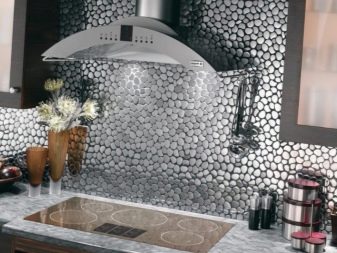
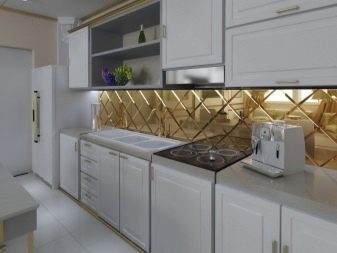
An unusual and rather budgetary option for decorating a kitchen apron is stickers. With their help, you can update the interior without undertaking a large-scale renovation, as well as embody the most original design ideas. Also, stickers are able to hide small chips, irregularities or damage on an existing apron.
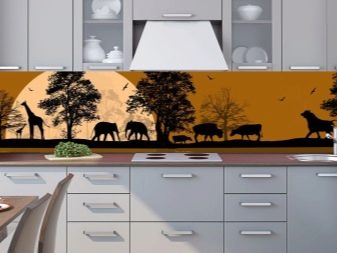

The ease of installation of stickers and the ease of dismantling and replacing them will allow you to periodically update the apron and change the pictures to more fashionable in the season. The stickers have a self-adhesive element in the base, adhere tightly to the surface and are highly wear-resistant - a protective agent against steam, water and grease is applied to their surface.
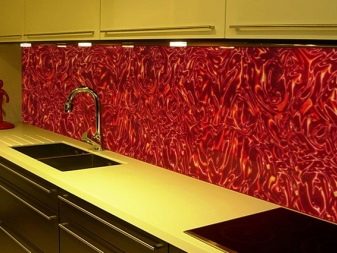
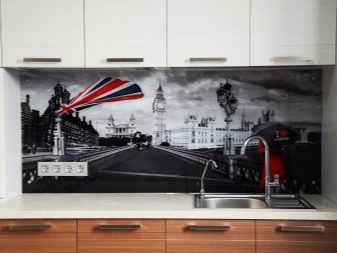
Manufacturers
Among the variety of offers in the rating of the most popular are two companies that are preferred by Russian consumers. Familiarity with their products will also help you navigate many other manufacturing firms.
- Albico. Domestic development, in the creation of which the leading European furniture manufacturers participated. The company specializes in high strength MDF kitchen aprons. The material is impregnated with antibacterial and water-repellent compounds and covered with a layer of protective film. The thinnest plastic coating on the front side not only protects the panel from moisture and fungus, but also opens up a wide scope for design options and colors.
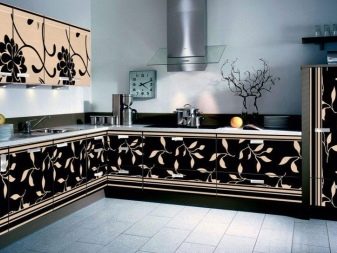
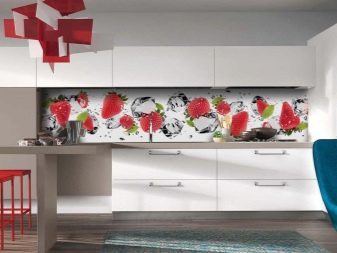
- Ikea - a recognized leader in the furniture market - offers a wide range of high pressure treated plastic panels. The material is durable, resistant to moisture and high temperatures, easy to cut and install. Tempered glass panels of different textures (transparent, matte) and colors are no less popular. In addition, Ikea offers a wide range of double-sided panels - they can be turned over, updating the interior without replacing the material itself.
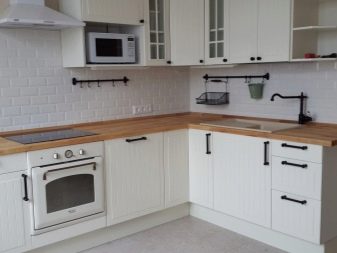
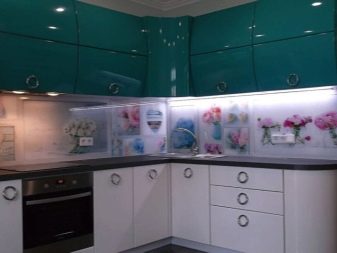
How to choose?
So, we can summarize some of the results. An apron for the kitchen must meet certain requirements, which should be highlighted in separate points and taken into account when planning:
- material resistance to high temperatures;
- moisture resistance;
- ease of care.
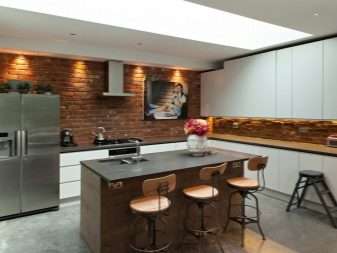
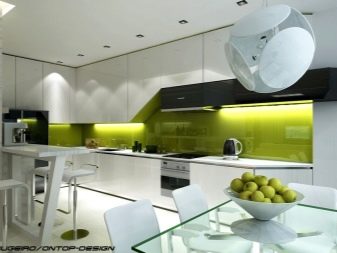
In addition to technical characteristics, design points are taken into account at the planning stage:
- the wall panel should be in harmony with the interior of the kitchen;

- light shades visually expand the space;
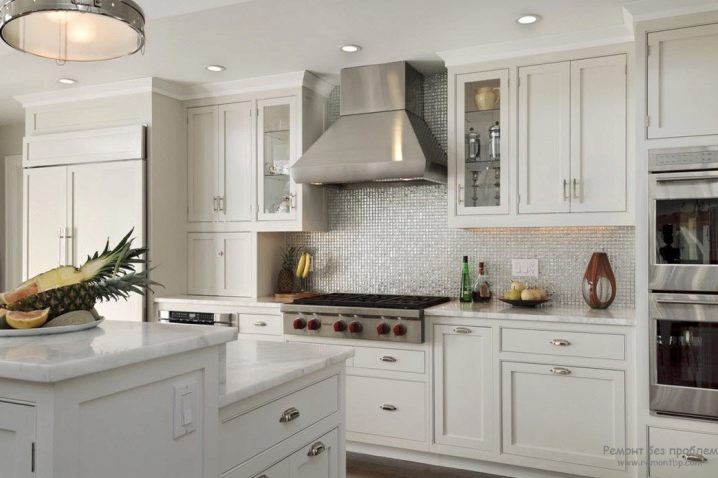
- glossy surfaces enhance brightness, while matte, on the contrary, muffle;

- in a small room, it is better to avoid macro images, limiting yourself to a smaller drawing or pattern;
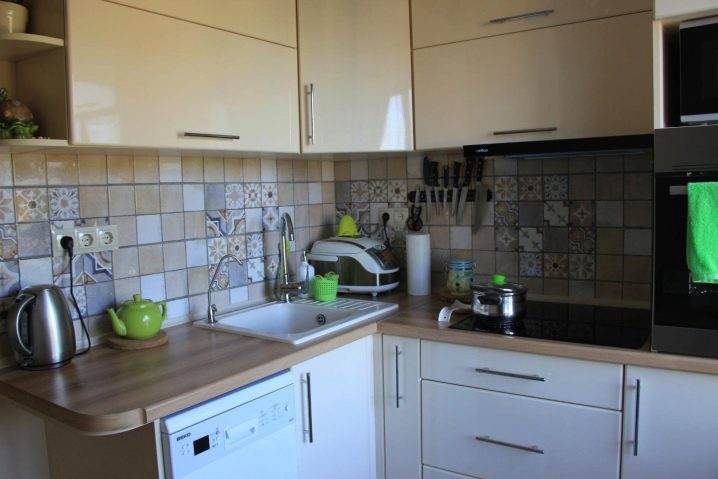
- horizontal lines create the effect of increasing space in width, and vertical lines in height;
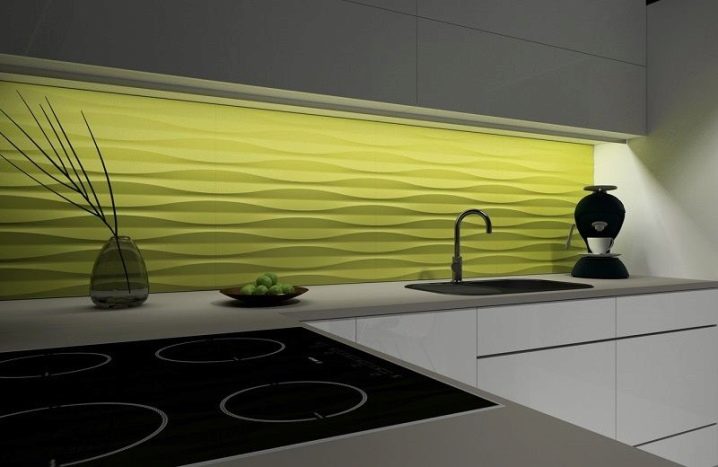
- mirrored aprons are a great way to "duplicate" a room, visually doubling it;
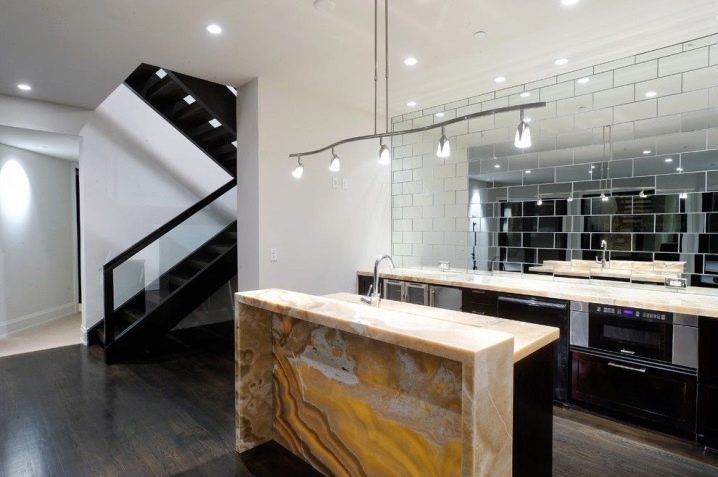
- it is easier to care for a smooth surface, without a relief, however, drops and stains are more clearly visible on it.
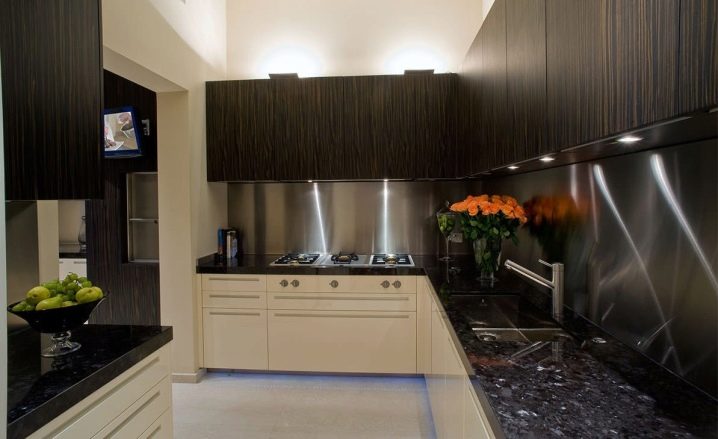
Whichever option is chosen, the material should be purchased with a 10% margin. The exception is solid glass and plastic panels.
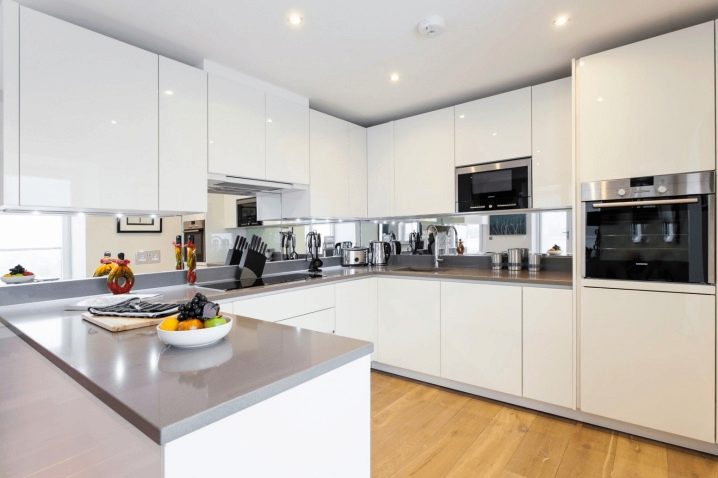
Beautiful examples
You can come up with original ideas for aprons yourself or look in the catalogs of manufacturers.
- For a large high-tech kitchen, a combination of a white-orange headset and a dark apron depicting a night metropolis is suitable.
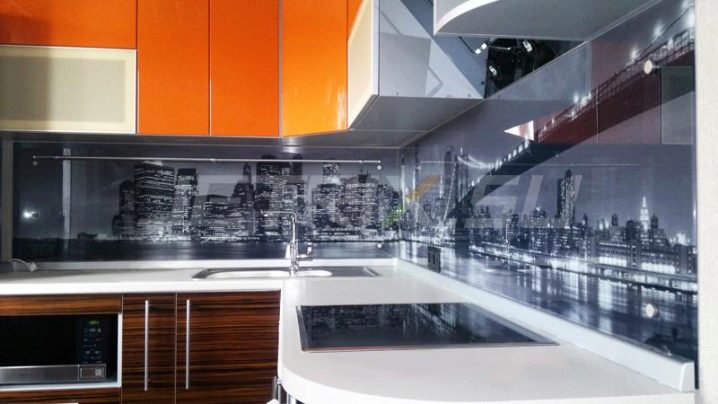
- Provence style is for lovers of gentle pastel colors. For example, tiles styled as limestone.
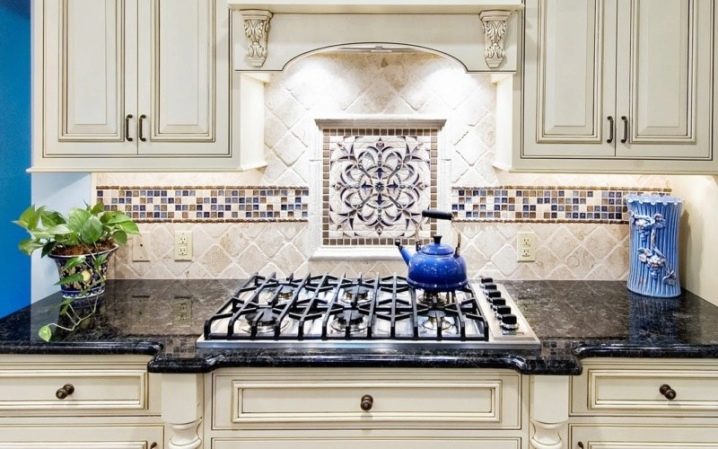
- A mirror apron visually doubles the room.
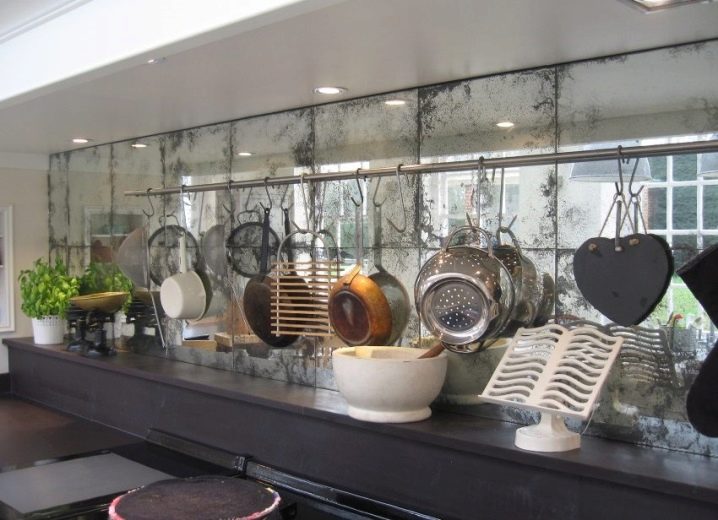
- For country style, a wooden apron is ideal.
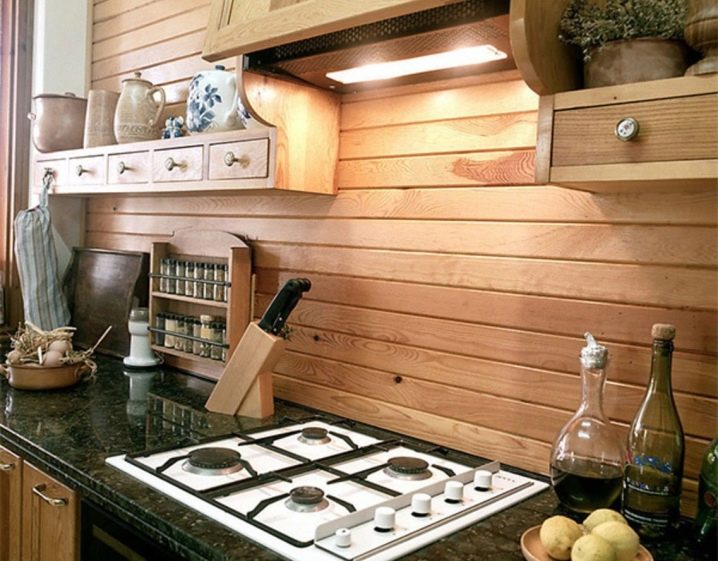
- An unusual solution can be a slate apron. It is convenient to write down wishes for dishes, make lists of products or announce a menu on it.

For more on kitchen aprons, see the video below.













The comment was sent successfully.